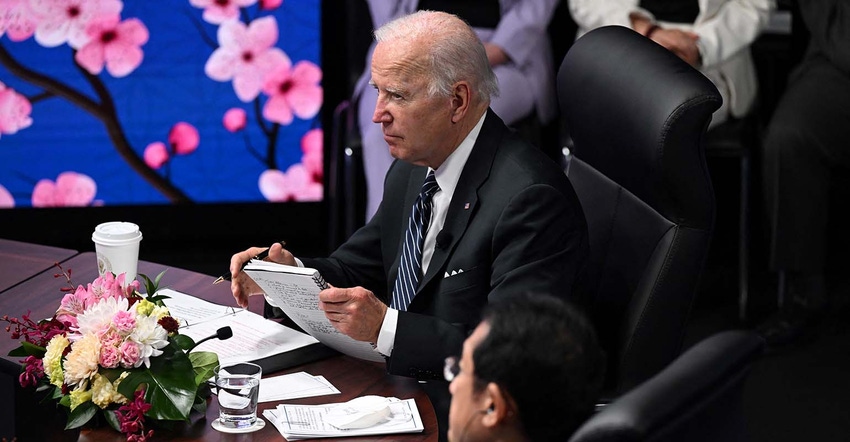
Over the weekend in Tokyo, Japan, President Joe Biden launched the Indo-Pacific Economic Framework for Prosperity to strengthen supply chains and create a more resilient economy for American workers and families with a dozen initial partners.
Together, the 12 countries – Australia, Brunei, India, Indonesia, Japan, Republic of Korea, Malaysia, New Zealand, the Philippines, Singapore, Thailand and Vietnam – represent 40% of world GDP. With 60% of the world’s population, the Indo‑Pacific is projected to be the largest contributor to global growth over the next 30 years. Trade with the Indo-Pacific supports more than three million American jobs and is the source of nearly $900 billion in foreign direct investment in the United States.
“The United States is an Indo-Pacific economic power and expanding U.S. economic leadership in the region is good for American workers and businesses — as well as for the people of the region. IPEF will enable the United States and our allies to decide on rules of the road that ensure American workers, small businesses, and ranchers can compete in the Indo-Pacific,” according to a fact sheet on the framework launch.
The framework focuses on four pillars to deepen the economic engagement in the region: connected economy, resilient economy, clean economy and fair economy.
In comments made in Japan, Biden says the framework will create first-of-its-kind supply chain commitments to eliminate bottlenecks in critical supply chains and develop early warning systems so we can identify problems before they occur.
“Let’s pursue other first-of-its-kind commitments to clean energy and decarbonization,” Biden adds. “The climate crisis is an existential threat that is costing us trillions in economic damage, but there’s also incredible potential and opportunity to solve problems and create good jobs by transitioning to a clean energy economy.”
“The Indo-Pacific Economic Framework is a chance for the U.S. and our allies to write the rules of the road for trade, undermining China's ability to spread its authoritarian model, and improve supply chain routes with like-minded countries in Asia. It’s a crucial counterweight to the Chinese government’s model of trade cheating, government subsidies and repression,” says Ron Wyden, D-Ore., who serves as the Senate Finance Committee chairman.
Lack of market access focus
However, agricultural groups have sought for an approach that also addresses market access as many other previous agreements include.
Dozens of members of Congress from both parties have underscored to the administration the importance of securing market access gains in IPEF. On March 30, a bipartisan group of 87 House members urged the Biden administration to prioritize agriculture in IPEF negotiations and outlined examples of both tariff and nontariff results that should be pursued. On May 9, two dozen Senate Republicans wrote to U.S. Trade Representative Ambassador Katherine Tai and Secretary of Agriculture Tom Vilsack to urge the inclusion of market access and enforceable commitments in IPEF.
“The launch of the new Indo-Pacific Economic Framework is a positive step, and we hope additional progress will quickly follow. Trade is critical to the success of U.S. farmers and ranchers, including improving relationships and reaching new agreements with this region’s countries,” says Zippy Duvall, president of the American Farm Bureau Federation. “The IPEF will help reduce barriers, improve the adoption of science-based standards and grow American agricultural exports to the region.”
Duvall says AFBF will urge the administration to work with other nations through the new Indo-Pacific Economic Framework to expand access to American goods throughout the world.
The National Milk Producers Federation and the U.S. Dairy Export Council welcomed the framework as an opportunity it offers to strengthen ties with key trading partners across the Asia-Pacific region. Exports are exceptionally important to the U.S. dairy industry. The United States exported $7.75 billion in dairy products worldwide in 2021, equivalent to approximately 17% of total U.S. milk production.
“Today marks an essential first step on what will surely be a complex journey,” says Jim Mulhern, president and CEO of NMPF. “But to successfully compete in the Asia-Pacific region and meet their demand for dairy, we ultimately need a level playing field. That means tackling both tariff and nontariff barriers that weigh down the ability of U.S. dairy exporters to keep pace with EU and Oceania competitors that have successfully negotiated agreements across the region.
Mulhern says NMPF urges the Biden administration to set specific time frames for IPEF negotiations so that it can deliver meaningful results for American dairy farmers. “We cannot afford another Trans-Pacific Partnership-type outcome in which we negotiate for six years only to walk away from the final result, leaving our exporters no further down the road than where we started,” he says.
Krysta Harden, president and CEO of the USDEC, adds, “If IPEF is crafted to include meaningful market access improvements and address non-tariff barriers, then these regional trends will help drive economic benefits for American farmers, dairy manufacturers and industry workers for decades to come.”
While supporting the use of IPEF and other targeted trade tools to advance exports, USDEC and NMPF have been unyielding in their call for once again pursuing comprehensive trade agreements around the world, and especially in the Asia-Pacific region, where competitors like the EU and Oceania have been especially active.
USDEC and NMPF filed comments on the IPEF trade agreement on April 11. The filing noted, “NMPF and USDEC’s priority and strong preference is the pursuit of comprehensive trade agreements to establish lasting trade barrier reductions on both the tariff and nontariff fronts. Recognizing that the Indo-Pacific Economic Framework is not likely to be such an agreement, we nevertheless urge the administration to seek to eliminate or reduce both tariff and nontariff barriers to U.S. dairy exports through the IPEF.”
About the Author(s)
You May Also Like






